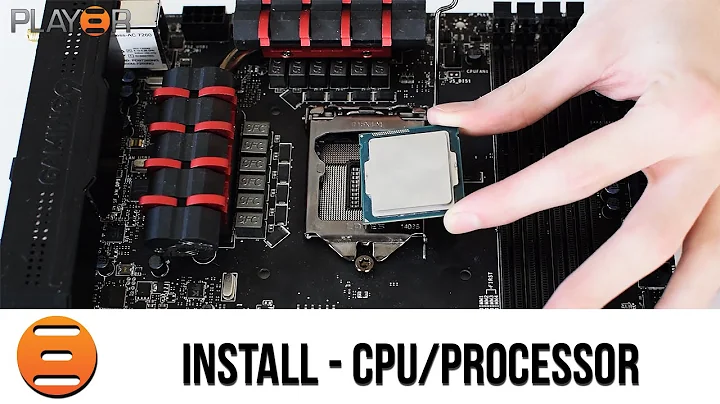Unleashing the Power of Intel Arc GPUs: A Comprehensive Review
Table of Contents:
- Introduction
- Overview of Intel graphics card
- Compatibility and performance comparison with AMD
- Limitations in using Intel graphics card for advanced tasks
- Challenges for developers in optimizing software for Intel hardware
- Nvidia's dominance in GPU-based compute and their technologies
- Intel's efforts in unifying their compute APIs
- Advantages of Intel's one API for developers
- Future support for tensor cores and XE Matrix extensions
- Current limitations and the need for Nvidia cards
- Criticism of hardware reviewers and their approach
Article:
Introduction
👋 Welcome to another insightful discussion about graphics cards! In this article, we will be exploring the capabilities of Intel graphics cards and discussing their compatibility, performance, and limitations compared to AMD and Nvidia. We will also delve into the efforts made by Intel to improve their hardware and APIs, and shed light on the ongoing challenges faced by developers. So, let's dive right in!
Overview of Intel Graphics Card
Intel graphics card has come a long way and can now handle most games without any major issues. While it may not offer the same level of performance as some high-end cards from competitors, it is certainly a commendable first attempt by Intel. In terms of compatibility, Intel's graphics card stands on par with AMD's offerings, which is a positive development for the market as competition drives innovation.
Compatibility and Performance Comparison with AMD
When it comes to compatibility, Intel's graphics card proves to be a reliable choice. However, in terms of raw performance, it may lag behind some of AMD's offerings. This is not to say that Intel's graphics card is inadequate; rather, it highlights the need for further optimization and advancements. Nevertheless, the fact that Intel has managed to establish itself as a viable option is a promising sign for the industry.
Limitations in Using Intel Graphics Card for Advanced Tasks
While Intel's graphics card may be sufficient for gaming purposes, there are certain limitations when it comes to more advanced tasks. For example, generating anime girls using Stable Diffusion or utilizing programs like Daz Studio or rendering software is currently not feasible on Intel hardware. These limitations can be frustrating for users with specific requirements, as they are forced to rely on other hardware solutions.
Challenges for Developers in Optimizing Software for Intel Hardware
Developers face a significant challenge in optimizing their software for Intel hardware, mainly due to the lack of widespread adoption. Without a considerable user base, it becomes difficult for developers to prioritize compatibility and invest resources in making their applications work seamlessly with Intel's graphics cards. This creates a chicken-and-egg situation, where developers hesitate to invest in Intel support without a substantial user demand, and users hesitate to adopt Intel hardware without adequate software compatibility.
Nvidia's Dominance in GPU-Based Compute and Their Technologies
Among graphics card manufacturers, Nvidia has a significant advantage in GPU-based compute. Their compute language, CUDA, has been around since 2007 and has allowed developers to harness the power of Nvidia's GPUs effectively. Additionally, Nvidia's OptiX, a ray tracing API introduced in 2009, further solidifies their position in the market. Nvidia has been successful in building and maintaining a strong ecosystem that supports their technology, making it challenging for competitors to displace them in this domain.
Intel's Efforts in Unifying Their Compute APIs
Recognizing the necessity to compete with Nvidia in GPU-based compute, Intel has been working on consolidating their compute APIs into a unified framework called one API. With one API, Intel aims to simplify the development process by providing a universal language, termed Sickle, that can convert CUDA-compatible code to work on Intel hardware. This initiative demonstrates Intel's commitment to supporting developers and making their hardware more accessible, bridging the gap between different ecosystems.
Advantages of Intel's One API for Developers
Intel's one API offers several advantages to developers. One notable benefit is the ease of converting CUDA-compatible code to Sickle, allowing developers to port their existing codebase with minimal effort. This significantly reduces the barrier to entry for developers who want to expand their applications to support Intel hardware. Additionally, by unifying different compute APIs, Intel simplifies the development process and encourages cross-platform compatibility, making it easier for developers to create applications that work seamlessly across various graphics card brands.
Future Support for Tensor Cores and XE Matrix Extensions
In the near future, Intel plans to add support for tensor cores and XE Matrix extensions through their one API framework. This development aligns them more closely with Nvidia, as they aim to provide features comparable to Nvidia's tensor cores and RT cores found in their RTX graphics cards. This support will further enhance Intel's hardware capabilities, enabling developers to leverage advanced technologies for tasks such as AI processing and real-time ray tracing. However, it's important to note that this support is projected for the first quarter of 2023, and until then, Nvidia remains the go-to option for users who require these specific functionalities.
Current Limitations and the Need for Nvidia Cards
Despite Intel's efforts and advancements, Nvidia still holds a dominant position in the market for a reason. Nvidia graphics cards simply work and offer unparalleled performance. They are particularly beneficial for users who require substantial VRAM for intensive tasks like video editing and rendering. While Intel's graphics cards may be suitable for gaming, the demanding nature of certain applications necessitates the use of Nvidia cards, despite their higher price tags. As technology continues to advance, it will be interesting to see if Intel can bridge this performance gap and provide a compelling alternative to Nvidia.
Criticism of Hardware Reviewers and Their Approach
It's vital to address a concerning trend in the tech industry, where some hardware reviewers fail to thoroughly explore the capabilities of Intel graphics cards and other hardware alternatives. This trend, exemplified by channels like Linus Tech Tips, undermines the potential of emerging technologies. Reviewers often fail to dive deeper into the functionality and possibilities offered by these hardware solutions. Access to such technology is limited, leading to a lack of comprehensive reviews and insights. It is essential for reviewers to invest more time and effort into exploring and understanding different hardware offerings to provide accurate and valuable information to consumers.
Highlights:
- Intel graphics card offers compatibility similar to that of AMD, providing more options for consumers in the market.
- While Intel's graphics card may not offer the same performance as high-end options, it is a commendable first attempt by Intel.
- Limitations exist for advanced tasks such as generating anime girls or utilizing rendering software on Intel hardware.
- Developers face challenges in optimizing software for Intel hardware due to the limited user base and compatibility issues.
- Nvidia's dominance in GPU-based compute, with technologies like CUDA and OptiX, poses a significant challenge for competitors.
- Intel's one API aims to unify their compute APIs, simplifying the development process and offering conversion tools for CUDA-compatible code.
- Support for tensor cores and XE Matrix extensions is expected in Intel graphics cards in the future, enhancing their capabilities.
- Despite improvements, Nvidia remains the preferred choice for tasks requiring high performance and extensive VRAM.
- Some hardware reviewers have been criticized for not thoroughly exploring the capabilities of alternative hardware options.
- Reviewers should invest more time and effort into understanding and showcasing the potential of emerging technologies.
FAQs:
Q: Can Intel graphics cards compete with Nvidia and AMD in terms of performance?
A: While Intel graphics cards have made significant progress, they still lag behind Nvidia and AMD in terms of raw performance. However, Intel's focus on improving their hardware and APIs shows promise for future advancements.
Q: Can I use Intel graphics cards for advanced tasks like rendering and using specialized software?
A: Intel graphics cards have certain limitations when it comes to advanced tasks such as rendering and using specialized software. Users may encounter compatibility issues and suboptimal performance for these types of tasks.
Q: What advantages does Intel's one API offer to developers?
A: Intel's one API simplifies the development process by providing a universal language, Sickle, which allows developers to convert CUDA-compatible code to work on Intel hardware. This facilitates cross-platform compatibility and reduces the barrier to entry for developers.
Q: Does Intel plan to support advanced technologies like tensor cores and real-time ray tracing?
A: Intel has plans to add support for technologies like tensor cores and XE Matrix extensions in their graphics cards. This is expected to bring them closer to Nvidia's capabilities, but such support is projected for the first quarter of 2023.
Q: Why do some users still prefer Nvidia cards despite Intel's advancements?
A: Nvidia cards are known for their reliability, performance, and extensive VRAM, which makes them suitable for tasks like video editing and rendering. Until Intel closes the performance gap and offers comparable features, Nvidia remains the preferred choice for these demanding tasks.
 WHY YOU SHOULD CHOOSE TOOLIFY
WHY YOU SHOULD CHOOSE TOOLIFY



































